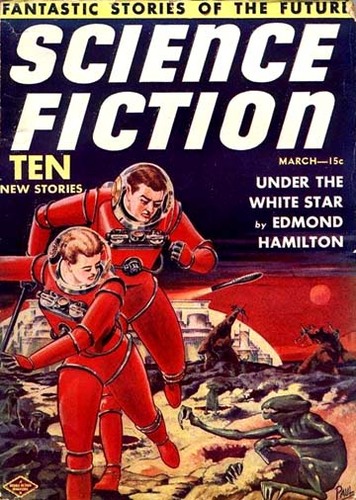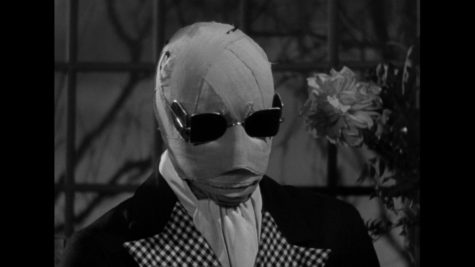Cyber-Ethics: The Science in Sci-Fi
An analysis of the problems that the science in science fiction creates.

Frank R. Paul, Public domain, via Wikimedia Commons
Here is the cover of Science Fiction magazine from March 1939. Science Fiction as a genre raises many ethical questions with the science that is depicted.
When you hear the phrase science fiction, what do you envision? Do you see streets stippled with neon lights, flashing green, purple and pink rays into your cybernetic eye as announcements of the new security protocol play over the thousands of billboards plastered on hundreds of high-rises? Or, do you think of clockwork cities built on cog-work machinery and steam engines that power zeppelins which carry aristocrats dressed in Victorian era clothing waving good day to the diseased soot-covered workers below? And if not those, what about quaint villages built from alchemical and chemical innovations spewing fumes and noxious gasses? When you look at the fine details of this world, you encounter many problems with how their science actually works. As a result, no matter what fantastical world you think of, the question of “is it ethical?” always arises. So let’s dive into three classic science fiction books and raise some questions about the ethics of the science present.
The Invisible Man
The Invisible Man by H. G. Wells is a classic within the science fiction genre and is often considered the first real science fiction novel. The book follows Griffin, the titular invisible man, and his attempts to become visible once again.

This book raises the question of how invisibility impacts its user. This idea is expanded on within the video game franchise, Fallout. The game deals with the possible neurochemical impacts of invisibility through the Nightkins, schizophrenic mutants who have become addicted to the power of invisibility. When their invisibility is taken away, they grow terrified, paranoid, and enraged. The case of the Nightkins raises many ethical problems about what invisibility does to its user. Generally, people enjoy the privilege of secrecy and privacy, making invisibility seem attractive. But this ability also creates paranoia for those that use it, as once the user enjoys perfect privacy, they may feel exposed or watched when their invisibility is stripped from them. As such, who is to say invisibility won’t just cause paranoia for everyone involved?
The Invisible Man also raises a second question; are there positive applications of invisibility? Although many dream of being invisible in some fantasy scenario, , the actual effects of invisibility could only be negative to society. The only practical use of invisibility is to gain access to restricted areas, which really has no everyday applications. It may be useful for the military to conduct covert operations and espionage more effectively; or for the police to gather intelligence more securely and perform actions more secretively. But every one of these positives are outweighed by the major issue, that invisibility provides a safe haven for criminal activity such as larceny, assault, and smuggling. In The Invisible Man, invisibility gave Griffin a way to escape from punishments, as he was able to kill and threaten without any consequences. If one invisible man resulted in a catastrophe for a town, then an invisible society is likely to result in eternal paranoia and mayhem. So, isn’t invisibility extremely dangerous?
The Dead Man Walking
Although iconic in the horror genre, Frankenstein by Mary Shelley isn’t really talked about as a science fiction novel; yet, Frankenstein contains just as, if not more elements of science than the Invisible Man, as it focuses more on the ramifications of science. Frankenstein follows the story of Dr. Victor Frankenstein as he recounts his creation of a monstrosity and how it has rampaged around town, destroying his life as well as the lives of those around him.
Just like with invisibility, the science of reanimation is often very self-centered, as those who seek to reanimate the dead often do so to fulfill a personal goal such as meeting a deceased family member or a famous celebrity . But this doesn’t mean reanimation and resurrection is an unethical technology. After all, H.P. Lovecraft’s Herbert West-Reanimator demonstrates the idea of using reanimation as a way to save dead patients. This, however, raises more questions than it answers. At what point should a person who’s dead stay dead? Whose decision should dictate who is resurrected? Of who’s care should the resurrected be placed on? These questions are easily answered if the target of reanimation was recently deceased, as their immediate family and age can often weigh in on these questions, but what if they were long gone? Do they still have a purpose in living?
Additionally, if we do have a purpose in reviving someone, like reviving great scientists and scholars to better society, does their knowledge and views still hold relevance in modern day? For example, if we were to resurrect Stephen Hawking, his scientific views and ideologies would likely still be relevant and be very helpful for he has only recently died. But what about someone like John Adams, who although was a great statesman, holds highly outdated views and would likely be quite unhelpful in modern politics. And with that, what if we revive a person who’s extremely detrimental to the world? If a group of people decide to resurrect a known villain, would we not suffer great consequences? So, just like invisibility, is it better if we don’t tread towards reanimation?
The Man of Wire and Steel
Do Androids Dream of Electric Sheep? by Phillip K. Dick is likely the first ever cyberpunk novel ever written as it explores the idea of a dystopian society where technology and crime are combined for a future fueled by capitalism and conflict. The book follows the story of Rick Deckard, a bounty hunter for the San Francisco police department, and his mission to decommission five droids that have gone haywire.
Although this novel raises many questions about the ethics of capitalism and how its development may impact society, regarding the technology of android Do Androids Dream of Electric Sheep? speaks of the ethics behind what makes an android less than a human. Androids, despite looking, acting, and expressing emotions like that of humans, are treated like second-class citizens. This is further explored in Star Wars, where droids are often being treated as second-class citizens by establishments and citizens due to their mechanical look. This follows patterns within our world, as we are torn by a variety of social, political, and economic differences. Who is to say that human-like machines won’t just create another fracture in our society?
But aside from the ethical questions raised by the book specifically, there are also more general questions with how androids impact the economy and societal problems. This is explored further in the game Detroit: Become Human by Quantic Dream, where androids replace humans in many workforces and relationships. This resulted in major divides between social classes and created outrage within the communities, causing people to protest against the existence of androids for taking their jobs. One major plotline within the game focuses on this as it displays the aftermath of a man whose job was replaced by an android. What happens to those who lose their livelihoods as a result of androids? Though automation has removed many jobs, androids threaten the elimination of all jobs. What happens then? Do we as a society just no longer progress?
The Probability of Sci-Fi
There are clear problems with science fiction when applied practically. So the question now is how close we are to that possibility.
Starting off with reanimation, as present in Frankenstein, this might not be so fictional after all. With defibrillators and CPR, we are already able to bring someone back from the brink of death. Defibrillators even use electricity, similar to common depictions of the reanimation of Frankenstein’s monster. But if you are more interested in the jigsaw-like reanimation of Frankenstein, well, look no further than organ transplants, where organs from a post-mortem body are moved to a living human to preserve their life. As for the Herbert West-Reanimator type of zombies, look no further than pufferfish toxin. Back in 1988, Wade Davis, a Harvard anthropologist, studied the effects of tetrodotoxin, a type of neurotoxin found in pufferfish, and found that it is possible to use tetrodotoxin to essentially create a trance like state for those that have consumed the toxin. Although this is not strictly reanimation, it still holds very interesting connections to the hypothetical science.
Invisibility by comparison, is something that has already been found in nature, but is still something people are attempting to recreate. In nature, this is found in the form of active camouflage, where animals are able to essentially mimic their surroundings and hide from others. An example of this is the cystisoma, a deepwater animal with clear skin and the ability to not refract light, which allows them to essentially be see-through against predators. As for human developments, in 2019, Hyperstealth Biotechnology patented the technology behind a material that bends light to make people and objects near invisible to the naked eye. Unlike traditional camouflage materials, which are limited to specific conditions such as forests or deserts, according to Guy Cramer, the CEO of HyperStealth, this “invisibility cloak” works in any environment or season, at any time of day. But even so, the problem of heat signatures means that any form of invisibility has to be improved to fight against moisture and heat in order to truly be invisible.
And finally, we reach the most interesting part of science fiction – androids. Androids are a questionable science because although we technically do have the technology to build them, we have to ask what really constitutes an android. By most popular definitions, an android is a humanoid, a human-like machine that is essentially capable of all tasks humans are able to do. And, by this definition, this science is much closer to us than we would think. But by a more strict definition of a “human-like” intelligence, we are still far away from making such a technology. As many roboticists are still debating the ethics of androids and its dangers.
So, what do we do with these ideas? Do we continue developing them and hope these ethical problems do not come back to haunt us? Or do we just stop with all developments and stay stuck in the mud? It’s impossible to say, but it’s an eventuality that we approach this type of technology if not a variation of it. So for now, what we must do is to keep an eye on these developments, and make sure they are at least on the line of being ethical.
When you look at the fine details of this world, you encounter many problems with how their science actually works. As a result, no matter what fantastical world you think of, the question of “is it ethical?” always arises. So let’s dive into three classic science fiction books and raise some questions about the ethics of the science present.
Tiankuo Zhang is an Editor-In-Chief for 'The Science Survey.' He sees journalism as something that has withstood the test of time and finds the transcriptions...










